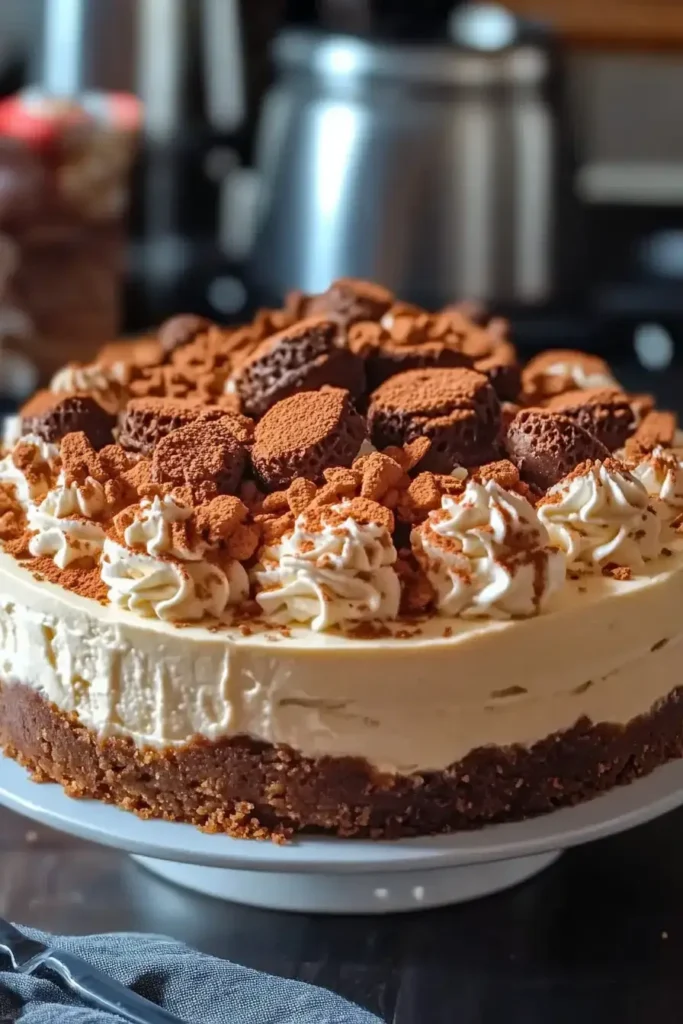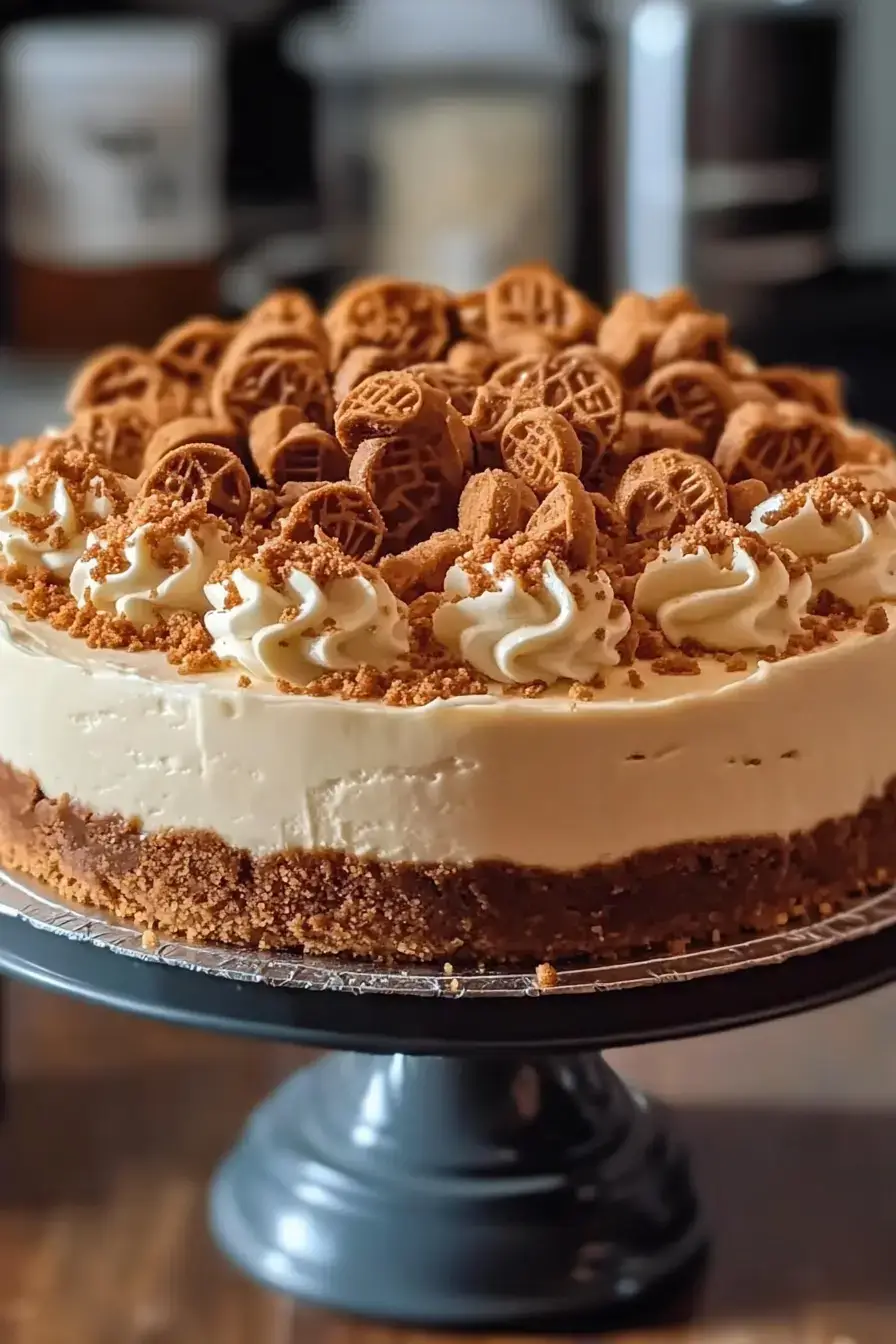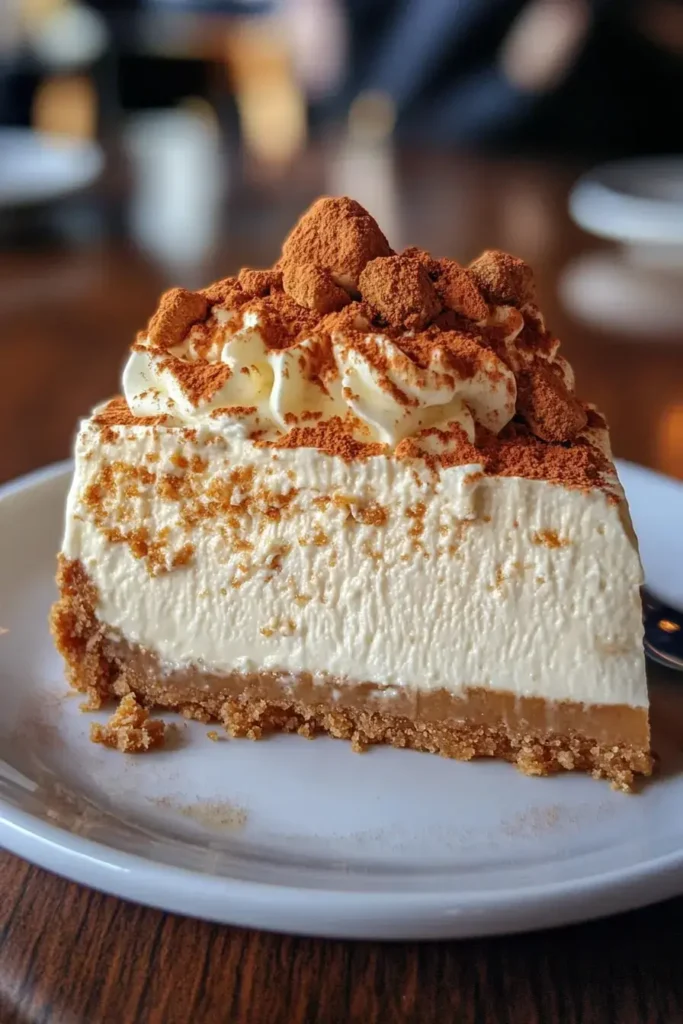Introduction
Why Biscoff Cheesecake Deserves the Spotlight
The allure of Biscoff Cheesecake lies in its irresistible blend of flavors and textures. This creamy dessert incorporates the bold spiced notes of Biscoff spread and cookies, offering a caramelized sweetness that stands out among traditional cheesecakes. Its velvety filling pairs beautifully with a buttery Biscoff cookie crust, creating a treat that is both comforting and indulgent.
The popularity of this cheesecake has skyrocketed due to its unique flavor profile and versatility. Whether served at a formal dinner or as a casual family dessert, Biscoff Cheesecake consistently impresses. Its rich flavor and aesthetic appeal make it a dessert worth sharing—and savoring.
A Global Favorite for All Occasions
From festive holidays to quiet afternoons, Biscoff Cheesecake adapts to any setting. It’s a versatile dessert that caters to various preferences, whether baked or no-bake. This adaptability ensures it remains a favorite choice for both novice and seasoned bakers.
For a perfect pairing, consider serving it alongside other crowd-pleasing recipes like our Crack Chicken Tenders Recipe. The savory crunch of the chicken complements the cheesecake’s creamy sweetness, creating a balanced and unforgettable dining experience.
As we dive into this comprehensive guide, you’ll discover everything you need to know about crafting the perfect Biscoff Cheesecake, including expert tips, essential tools, and creative variations.
What You’ll Need
Essential Tools for Biscoff Cheesecake
Creating a perfect Biscoff Cheesecake requires a few essential tools to ensure your dessert comes out smooth, creamy, and visually stunning. Here’s what you’ll need:
- Springform Pan: This is crucial for achieving that classic cheesecake shape and makes it easy to release your dessert without damaging its structure.
- Electric Mixer or Stand Mixer: For blending the cream cheese and other ingredients into a velvety filling, an electric mixer ensures a lump-free texture.
- Food Processor: Perfect for grinding Biscoff cookies into a fine crumb for the crust. If you don’t have one, a resealable bag and rolling pin will work as a substitute.
- Mixing Bowls: A few different sizes will help keep your ingredients organized.
- Offset Spatula: Useful for smoothing the cheesecake’s surface before chilling or baking.
Investing in these tools will make your cheesecake journey smoother and more enjoyable. If you’re new to baking or assembling equipment, don’t worry—many of these items double as kitchen essentials for other recipes like our Easy Cranberry Brie Thyme Phyllo Cups Recipe.
Additional Equipment for Baking and No-Bake Versions
Depending on whether you’re baking or opting for a no-bake version, you may need a few extras:
- Water Bath Setup (for baking): A large roasting pan and aluminum foil to create a humid baking environment. This prevents cracks on the cheesecake’s surface.
- Refrigerator Space: For the no-bake version, ensure you have enough space to chill the cheesecake for at least 4–6 hours or overnight.
- Measuring Cups and Spoons: Accurate measurements are vital for the perfect texture and balance of flavors.
Whether you choose the baked or no-bake route, having these tools ready will set you up for success.
Ingredients
The Building Blocks of Biscoff Cheesecake
To create a luscious Biscoff Cheesecake, you’ll need a carefully curated list of ingredients. Each component contributes to the overall texture and flavor, ensuring your dessert is both rich and satisfying.
the Crust
- Biscoff Cookies (200g): These caramelized, spiced cookies form the perfect base for the cheesecake. They add a signature crunch and flavor.
- Unsalted Butter (6 tbsp, melted): Helps bind the cookie crumbs together, creating a sturdy crust that complements the creamy filling.
the Cheesecake Filling
- Cream Cheese (500g, softened): The heart of the cheesecake, providing a smooth and creamy texture. Full-fat cream cheese works best for a rich consistency.
- Biscoff Spread (1 cup): Adds the unmistakable caramel flavor that makes this cheesecake unique.
- Heavy Cream (1 cup): Ensures the filling is light yet velvety, balancing the density of the cream cheese.
- Powdered Sugar (½ cup): Sweetens the filling without adding grittiness.
- Vanilla Extract (1 tsp): Enhances the overall flavor profile with a subtle hint of sweetness.
For the Topping
- Biscoff Spread (½ cup, melted): Drizzle this over the top for a glossy, indulgent finish.
- Whipped Cream: Optional, but adds a light and airy contrast to the dense filling.
- Biscoff Cookies (for garnish): Crumbled or whole cookies provide an aesthetic touch and extra crunch.
Ingredient Tips and Substitutions
- If you can’t find Biscoff cookies, graham crackers with a dash of cinnamon make a great alternative.
- For a dairy-free version, use plant-based cream cheese and coconut cream as substitutes.
Including quality ingredients will ensure a cheesecake that’s not just delicious but memorable. For more recipe inspiration, explore our Crack Chicken Tenders Recipe, which pairs beautifully with sweet desserts like this one.
Instructions
Step-by-Step Guide to Making Biscoff Cheesecake
Prepare the Crust
- Crush the Cookies: Use a food processor to pulse the Biscoff cookies into fine crumbs. Alternatively, place them in a resealable bag and crush them using a rolling pin.
- Combine Ingredients: In a mixing bowl, combine the cookie crumbs with melted butter. Mix thoroughly until the mixture resembles wet sand.
- Form the Base: Press the crumb mixture evenly into the bottom of a springform pan. Use the back of a spoon or a flat-bottomed glass to press and compact it. Chill in the refrigerator while preparing the filling.
Make the Filling
- Beat the Cream Cheese: In a large mixing bowl, beat the softened cream cheese with an electric mixer until smooth.
- Add Biscoff Spread and Sugar: Blend in the Biscoff spread, powdered sugar, and vanilla extract. Continue mixing until fully combined.
- Incorporate Heavy Cream: Slowly add the heavy cream while beating on low speed. Increase the speed to medium-high and beat until the mixture becomes thick and fluffy.
Assemble and Chill
- Pour the Filling: Spread the cheesecake filling evenly over the chilled crust, smoothing the top with an offset spatula.
- Chill: Refrigerate the cheesecake for at least 4–6 hours or overnight for the best results.
For more dessert inspiration, check out our Easy Cranberry Brie Thyme Phyllo Cups Recipe.
Nutrition Score
Understanding the Nutritional Value of Biscoff Cheesecake
Biscoff Cheesecake is undeniably indulgent, but it’s helpful to understand its nutritional profile to enjoy it mindfully. Here’s a breakdown per serving (based on a 10-slice cheesecake):
- Calories: Approximately 450 kcal
- Total Fat: 30g
- Saturated Fat: 18g
- Carbohydrates: 38g
- Sugars: 25g
- Protein: 6g
- Fiber: 1g
- Sodium: 250mg
Balancing Indulgence and Nutrition
- Rich in Flavor: The combination of cream cheese and Biscoff spread contributes to the cheesecake’s creamy texture and bold flavor.
- Moderation Matters: While high in calories and fats, this dessert is perfect for sharing, making smaller portions an excellent choice.
Pairing this cheesecake with lighter recipes, like our Crack Chicken Tenders Recipe, can help balance your meal while still indulging in something sweet.
Serving & Storage
Serving Tips for Biscoff Cheesecake
- Best Temperature: Serve your Biscoff Cheesecake chilled for the ultimate creamy texture and flavor. Remove it from the fridge about 10 minutes before slicing for easier handling.
- Garnish for Presentation: Add a drizzle of melted Biscoff spread on top and garnish with whipped cream and crushed Biscoff cookies to elevate the dessert’s appearance.
- Portioning: Use a sharp knife dipped in hot water to slice cleanly through the layers. Wipe the knife after each cut for perfect slices.
How to Store Biscoff Cheesecake
- Refrigeration: Cover the cheesecake securely with plastic wrap or store it in an airtight container. It will stay fresh for up to 5 days in the refrigerator.
- Freezing: For longer storage, wrap individual slices in cling film and place them in a freezer-safe bag. Thaw in the fridge overnight before serving.

Variations
Creative Twists on Biscoff Cheesecake
- No-Bake Biscoff Cheesecake
Skip the oven and opt for a no-bake version by using gelatin or whipped cream to set the filling. This variation is perfect for summer days when you want to avoid the heat. - Chocolate Biscoff Cheesecake
Add a chocolate twist by incorporating melted dark chocolate into the filling. You can also drizzle chocolate ganache on top or create a marbled effect with chocolate and Biscoff spread. - Mini Biscoff Cheesecakes
Transform this dessert into individual servings by using cupcake liners or small ramekins. This variation is great for parties or portion control.
Personalize It Further
Experiment with flavors by adding a hint of cinnamon or nutmeg to the crust or topping with fresh fruits like strawberries for a tangy contrast. Pair it with our Crack Chicken Tenders Recipe for a unique combination of flavors.
FAQs
What Flavor is Biscoff?
Biscoff has a distinct caramelized flavor with subtle hints of spices like cinnamon and nutmeg. Its warm, slightly spiced profile makes it a versatile ingredient for desserts like cheesecakes, cookies, and spreads. The flavor is comforting and indulgent, perfect for adding depth to sweet treats.
What is Lotus Biscoff Cheesecake Made Of?
Lotus Biscoff Cheesecake typically features a crumbly crust made from crushed Biscoff cookies, a creamy filling with cream cheese and Biscoff spread, and a decadent topping of melted Biscoff spread or crushed cookies. This combination creates layers of flavor and texture that make the dessert truly irresistible.
What is Biscoff Cake Made Of?
Biscoff cake includes ingredients like Biscoff spread in the batter or frosting, paired with traditional cake ingredients such as flour, sugar, and eggs. Some recipes even incorporate crushed cookies for added texture, creating a unique cake experience.
What is the Difference Between Sicilian Cheesecake and New York Cheesecake?
Sicilian cheesecake is made with ricotta cheese, giving it a lighter and more textured consistency. In contrast, New York cheesecake uses cream cheese for a dense, creamy texture. Both are delicious, but they offer distinctly different flavor profiles and mouthfeels.
For more dessert ideas, explore our Easy Cranberry Brie Thyme Phyllo Cups Recipe, which pairs wonderfully with sweet options like Biscoff Cheesecake.
Conclusion
Biscoff Cheesecake is a dessert that combines creamy indulgence with the warm, spiced flavors of Biscoff cookies and spread. Its versatility, whether baked or no-bake, makes it a perfect choice for any occasion. By following this guide, you can create a show-stopping dessert that’s sure to impress your family and friends. From the buttery crust to the velvety filling and caramelized topping, every bite is pure bliss.


